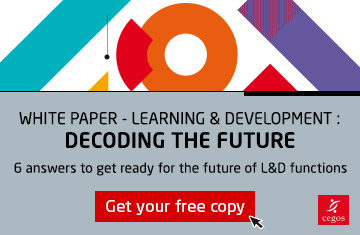What will the next generation of training videos look like?
Online video consumption in our everyday lives has taken off, indisputably. Everything now seems easily accessible via video –sometimes for free or at a low cost: I can access movies and series, archives, live events, user-generated content and more.
As a direct consequence, the video traffic will represent 82% of the overall Internet traffic by 2021 (source: Cisco). Each minute, 400 hours of video are uploaded and a third of a user's online activity is devoted to watching videos.
Even if video isn’t new in training, it would seem that it has many possibilities and opportunities for use.
How to take advantage of these trends and use videos to foster learning innovation and effectiveness?

1 – Use storytelling to capture your audience
Rather than just following the trend of “ever shorter,” we prefer to focus on dropping attention spans. You use the very first seconds to hook the learner, explain to them the benefits they can gain from the video and try to keep their attention for a longer time period. This approach is based on a fundamental storytelling principle, which the learners are used to when watching some television or web series: the hook, hold, payoff.
- The hook aims to capture the audience’s attention in the first few seconds, creating an emotion or tension between a character and a situation;
- The hold aims to hold attention by putting the character up against new challenges;
- The payoff aims to give the video a conclusion, whether happy or not!
Since these techniques require careful writing, in the case of content generated by users, it can be interesting to train those producing most of the content to adopt these storytelling codes and thus promote maximum commitment.
2 – Foster engagement and application
Video is an excellent tool for demonstrating technical "skills". But from a learning point of view, we shouldn't lose sight of the fact that in terms of efficiency, watching is not doing.
Here once again, video can prove to be very useful. The introductory videos for Cegos’ 4REAL approach, for example, immerse learners in situations they may encounter, and invite them to work on their perspectives as early as possible.
Viewing, recording, comparing, means we can increase the value of a skill, but it can never replace it.
It is therefore necessary to integrate video as one of the many tools within programmes that combining the 3 themes of the 70/20/10 method (experience / exchanges / formal).
3 – A video made just for me?
Another approach consists in enhancing the experience by offering a bite-sized nugget, capable of creating the sensation that it has been made just for the learner, for their needs in the here and now.
This practice is also possible by using the adaptive learning capabilities of some platforms that will “push” the right video to the learner according to a given professional context.
L&D leaders who activate these 3 levers will foster learner engagement and knowledge acquisition and transfer in the workplace.
Read the Cegos Innovation Book “L&D: decoding the future”, and find out more about the new challenges for Learning & Development leaders.









